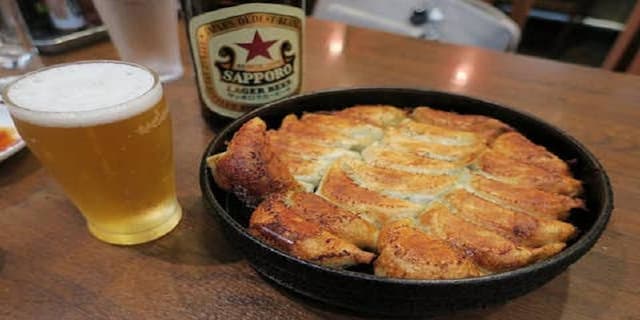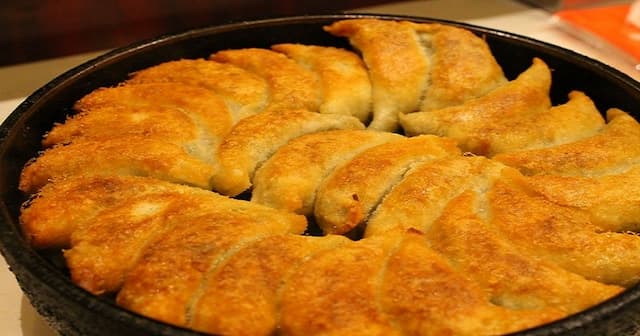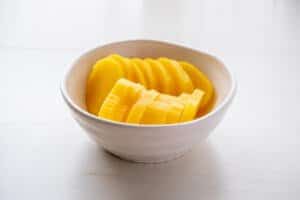Gyoza may be one of the most popular Japanese street food. However, do you know that there are a lot of types of Gyoza and how many kinds you have eaten? It might surprises you that there is not only normal gyoza but also some special Japanese kinds of Gyoza. Today, I want to introduce you about Tetsunabe Gyoza (鉄鍋餃子). Get ready to find out about what is Tetsunabe Gyoza, how to make it and where to eat the most delicious kind of dish!
What is Tetsunabe Gyoza?
Gyoza (餃子) is traditional Chinese dumplings with the fillers of vegetables, meat and wrapped in a thin dough. Although the origin of Gyoza is China, gyoza is among one of the most popular dishes in Japan apart from ramen. There are several ways of cooking Gyoza such as boiling, pan-frying, etc. Tetsunabe gyoza (鉄鍋餃子) is used to call a special local gourmet in Hakata that is served directly in a cast iron skillet. Therefore, this dish is sometimes called Hakata dumplings or Hakata gyoza.
Difference between normal gyoza and Tetsunabe gyoza
Served in an iron skillet: The most dishtinguishable characteristic of Tetsunabe gyoza is that it is served directly in an hot iron skillet. Normally, after the gyoza is grilled, it will be served on a plate with dipping sauce to customer. However, in Hakata, the gyoza is served in a pan so that the dish can keep the hot until customers finish eating.
Bite-size gyoza: Tetsunabe gyoza is also called bite-size gyoza as its size is smaller than the normal one. The gyozas are neatly lined up in the pan and each gyoza is just small size so customers can easily eat it.
History of Tetsunabe Gyoza

While gyoza is originally from China, the history of Tetsunabe Gyoza has a whole different story. the origin of “tetsunabe gyoza” is “Yamato Gyoza Main Store Tetsunabe,” a 3-minute walk from Kurosaki Station on the JR Kagoshima Main Line.
The store was founded in 1958 in Orio, Kitakyushu City and later moved to current Kurosaki. At that time, Yawata, Kitakyushu City was proud of its label as an “iron city”. The city was bustling and crowded with thousands of craftsmen.
The founder, Atsuko Uku (mother of Tomoki Uku, the second generation owner), once experienced gyoza made at a Chinese restaurant and then decided to make her own gyoza with Japanese style. Crisp-baked gyoza with light ingredients have turned this Chinese dish into Japanese food. Hoping to serve the piping hot gyozza to customers, the idea of serving in a hot iron pan was born and become popular up until now.
How to make Tetsunabe Gyoza?

Ingredient
| Ingredients (for 60 – 70 dumblings) | |
| Minced pork | 500g |
| Cabbage | 1/2 piece |
| Chopped chives | 1 bundle |
| Chopped green onion | 1 piece |
| Grated ginger | 2 tsp |
| Wine | 30 cc |
| Salt | 1 tsp |
| Soy sauce | 2 tbsp |
| Starch | 3 tbsp |
| Sesame oil | 5 tbsp |
| Pepper | 2 tbsp |
How to make Tetsunabe Gyoza?
- Wash the cabbage for about 15 minutes. Squeeze out the water and chop them.
- Chop chives and green onion.
- Grate ginger.
- Put cabbage, Chinese chives, green onions, ginger, and other seasonings in a large bowl and mix well, then add minced pork and potato starch.
After the mixture is mixed well, wrap the ingredients and arrange them in a tray. If you don’t want to fry all the gyoza, just keep them in the freezer. If this is your first time wrapping the gyoza, don’t worry and follow our instructions below!
Add a little sesame oil in the skillet and arrange the gyoza into the pan. Add water, put a lid on, turn the heat to high level and wait until the water evaporates. When the gyoza turns into the right color (golden brown), flip over and leave for about 7-8 minutes for the other side fully cooked.
After the Tetsunabe gyoza is done, serve the dish with dipping sauce and enjoy the food!
Tips for wrapping the gyoza
Making the gyoza is not really an easy cooking challenge at all. If you are not confident at your skills but still want to make Tetsunabe Gyoza at home, here are some tips for you.
STEP 1: Put the fillings into the wrapper
After finishing mixing the fillings, put a wrapper in the palm of your hand and add a small amount (about 1 tsp) of mixture in the center of the wrapper. Wet the outer of the wrapper with water to easily fold it.
STEP 2: Folding the wrapper
After putting the fillings into the wrapper, there are 2 method of folding the wrapper that you can easily follow:

METHOD 1: Pleats toward the center
In this method, you start to close the wrapper from the center toward the right. After finishing 3-4 pleats, continue to fold the same with the left side. Finally, press the pleats and shape the gyoza.
METHOD 2: Pleats towards one side
After wet the wrapper with water, fold the wrapper in half and carefully use your fingers to fold the wrapper from the right side to the left. Continue to wrap until the wrapper is fully closed, press the pleats and shape the gyoza.
Where to eat Tetsunabe Gyoza?
Hakata Gion Tetsunabe

A famous and long-established tetsunabe gyoza shop in Hakata. Just 3 minutes walk from exit 5 of Gion Station on the subway, it is very easy to find the way here. The gyoza is excellent with crispy texture and light ingredients served in a hot pan that you can enjoy the hot piping until finishing. Definitely one of the best place you should come over to experience when in Hakata.
Tetsunabe gyoza Nakayoshi (鉄なべ餃子なかよし)

Nakayoshi is among one of the most popular Fukuoka-style Tetsunabe gyoza in Tokyo. This is a long-established shop that seperated from Hakata Gion Tetsunabe. The gyoza here remains the Fukuoka-style flavour with fillers of vegetables such as cabbage and Chinese chives and is grilled until the skin is crispy. You can enjoy the gyoza without the sauce but if you want it to be more flavourful, try to eat it with a vinegar-soy sauce-based sauce and yuzu pepper. It is such a refreshing experience that you may want to eat more and more.
Tetsunabe Nakasu Honten (鉄なべ 中洲本店)

Since the day Tetsunabe Nakasu Honten opened, the recipe of this Japanese dumplings still remain the same. All the ingredients are domestically made in Japan and made by hand. The bite-sized dumplings are served on a sizzling iron skillet which ensures they are thoroughly cooked and won’t go cold before you eat them. You can also try the Tetsunabe Gyoza here with drinks like cold beer.
Gyoza Gojuban (ぎょうざ 五十番)

Gyoza 50 ban is a famous restaurant with over 50 years of experience. The restaurant mainly sells boiled gyoza and fried gyoza with rice. In this restaurant, they sell bite-sized dumplings with handmade skins and sweet bean paste made from cabbage. The skillful technique of judging the doneness by the sound you hear from the pot is impressive.
Gyoza-tei Tashiro (ぎょうざ亭 たしろ)

A specialty store famous for its tetsunabe gyoza. The gyoza dumplings here are carefully wrapped with a soft texture, have an elegant Japanese-style taste. If you are here in Kitakyushuu, put this restaurant in your checklist for an excellent experience with the amazaing Japanese style dumplings.
Takeaway

Gyoza may be very familiar to a lot of Japanese people. However, talking about Fukuoka cuisine, Hamata Tetsunabe gyoza is very popular. This special technique of serving gyoza in an iron skillet make the taste of the dish much more amazing than ever. The fillers may differ depending on the restaurants, but the soul of the dish is the combination of sweetness of cabbage, meat and the crunchy texture of the wrappers. If you are a gyoza lovers, don’t forget to experience this special dish from Hakata!
If you want to find more about gyoza, find out here!
















Comments